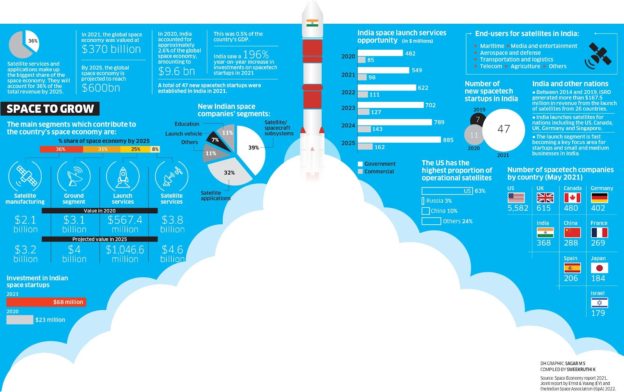Chinese rockets aren’t good options for many satellite operators, partly because of growing concerns about Beijing accessing Western technology. By contrast, India has moved closer to the US and other regional powers, including Australia and Japan, and the country’s launches cost less than other rivals.
India is muscling in on the increasingly lucrative business of space, taking advantage of the geopolitical isolation of China and Russia to pitch itself as a reliable alternative to SpaceX. State-owned NewSpace India Ltd. launched three dozen communications satellites last month from an island off the nation’s eastern coast for OneWeb Ltd. The move not only salvaged the UK satellite company’s bid to create a global broadband internet network in the skies, but also signaled India’s ambitions in the sector.
Demand for high-speed internet delivered from space has made launching satellites into orbit a prosperous business. By 2025, the so-called space economy is projected to grow to $600 billion from $447 billion in 2020, according to Ernst & Young estimates.
Along with Elon Musk’s SpaceX, Russia and China have been the main providers of satellite launches, given their long-running state space programs. But the war in Ukraine and Beijing’s tensions with the US mean they’re now off limits to many would-be customers. OneWeb turned to India after Russia scuppered the original launch last year, taking 36 of its spacecraft hostage.
At the same time, France’s Arianespace has suffered problems getting its newest rocket ready for use. And Virgin Orbit Holdings Inc., the satellite-launch company tied to British billionaire Richard Branson, said last week that it was ceasing operations indefinitely following a launch failure in January.
“If SpaceX is full, busy or expensive, you have to look elsewhere – and you can’t look at China,” said Dallas Kasaboski, principal analyst with Northern Sky Research, a space research and consulting firm. “China can’t work with North America and the US drives the majority of demand.”
“Politically, India is in a much better place,” he said.
Chinese rockets aren’t good options for many satellite operators, partly because of growing concerns about Beijing accessing Western technology. By contrast, India has moved closer to the US and other regional powers, including Australia and Japan, and the country’s launches cost less than other rivals. Developing the space sector is a key plank of Prime Minister Narendra Modi’s “Make in India” campaign, which aims to position the world’s fifth-largest economy as a top destination for technological innovation. His administration has tried to make India’s space agency more business friendly by encouraging the growth of startups.
“Demand is so huge,” said D. Radhakrishnan, the chairman and managing director of NewSpace, which was created in 2019 as the commercial arm of the national space agency, the India Space Research Organisation. “There’s going to be a lot of shortage of the heavy-lift launchers that will be required.”
Taking on China
NewSpace should help India compete on the global stage. The March 26 launch follows a successful operation in October, when the company launched another 36 satellites for OneWeb. NewSpace is ramping up production of India’s largest domestically developed rocket — the LVM3. Neil Masterson, the chief executive of OneWeb, said NewSpace has “a real opportunity to be a mainstream commercial launch provider.” Last fiscal year, the company posted revenue of 17 billion rupees ($210 million) and profit of 3 billion rupees ($41 million). NewSpace provided satellite launch services for 52 international customers.
More broadly, India’s industry is on track for significant growth. In 2020, the government eased rules for private sector satellite and rocket companies, allowing them to carry out independent space activities instead of being solely the suppliers to ISRO. The reforms mean that startups can also access ISRO’s facilities, such as launchpads and laboratories. By 2025, the value of India’s satellite launch services could almost double to $1 billion.
India still has far to go before it catches China. As of March 2020, China owned 13.6% of all earth-orbiting satellites, compared to 2.3% for India, according to the Center for Strategic and International Studies, a think tank in Washington.
Last year, China conducted 64 launches, the Communist Party-backed newspaper Global Times reported. While most private companies in China are still developing their rockets, a few have managed orbital launches on their own. In March 2022, the Beijing-based startup GalaxySpace placed six communications satellites into low-earth orbit and rival Galactic Energy, also headquartered in China’s capital, added five more in January. By comparison, India managed five similar launches last year — all of them by ISRO or NewSpace. Only a few are planned for 2023.
Ensuring Reliability
In the past, India’s rockets have also suffered from reliability issues. The country’s success rate in recent years of about 70% compares poorly to rates in the 90s for rockets from the US, Europe, Russia or China, according to Jonathan McDowell, an astrophysicist at the Center for Astrophysics, which is operated by Harvard University and the Smithsonian Institution.
When choosing to launch in India, he said, “you’re accepting a slightly higher risk of failure.” But even with that backdrop, India is doing well, he said. The nation remains a popular choice for cost-efficient launches: In 2013, India sent an orbiter to Mars for a 10th of the price of a NASA probe that went the same year. “There aren’t many players that have a large-capacity launch vehicle that’s cheap,” McDowell said. “And that’s not China or Russia.”
https://www.financialexpress.com/economy/india-is-taking-on-china-in-the-447-billion-space-economy/3034352/





